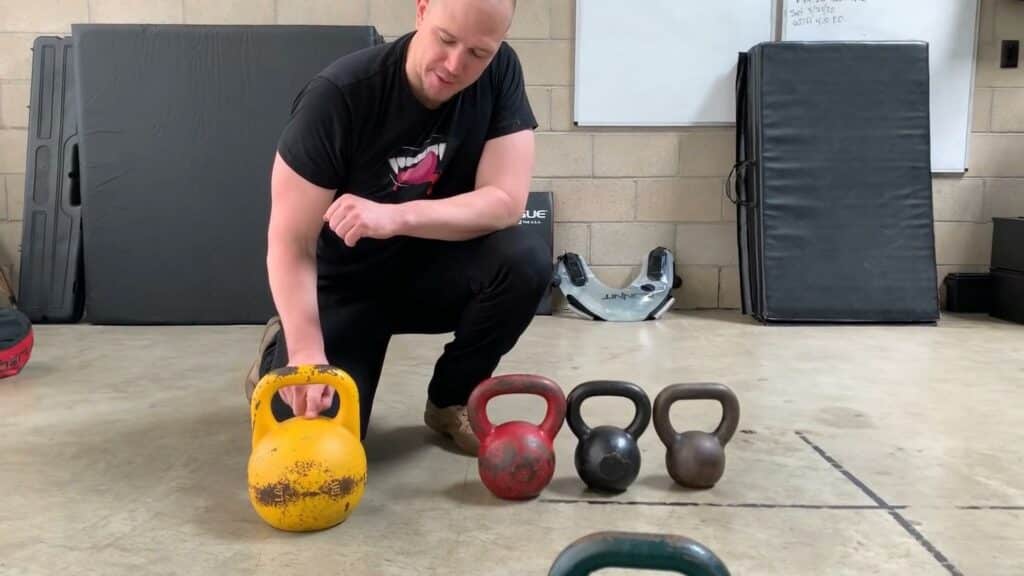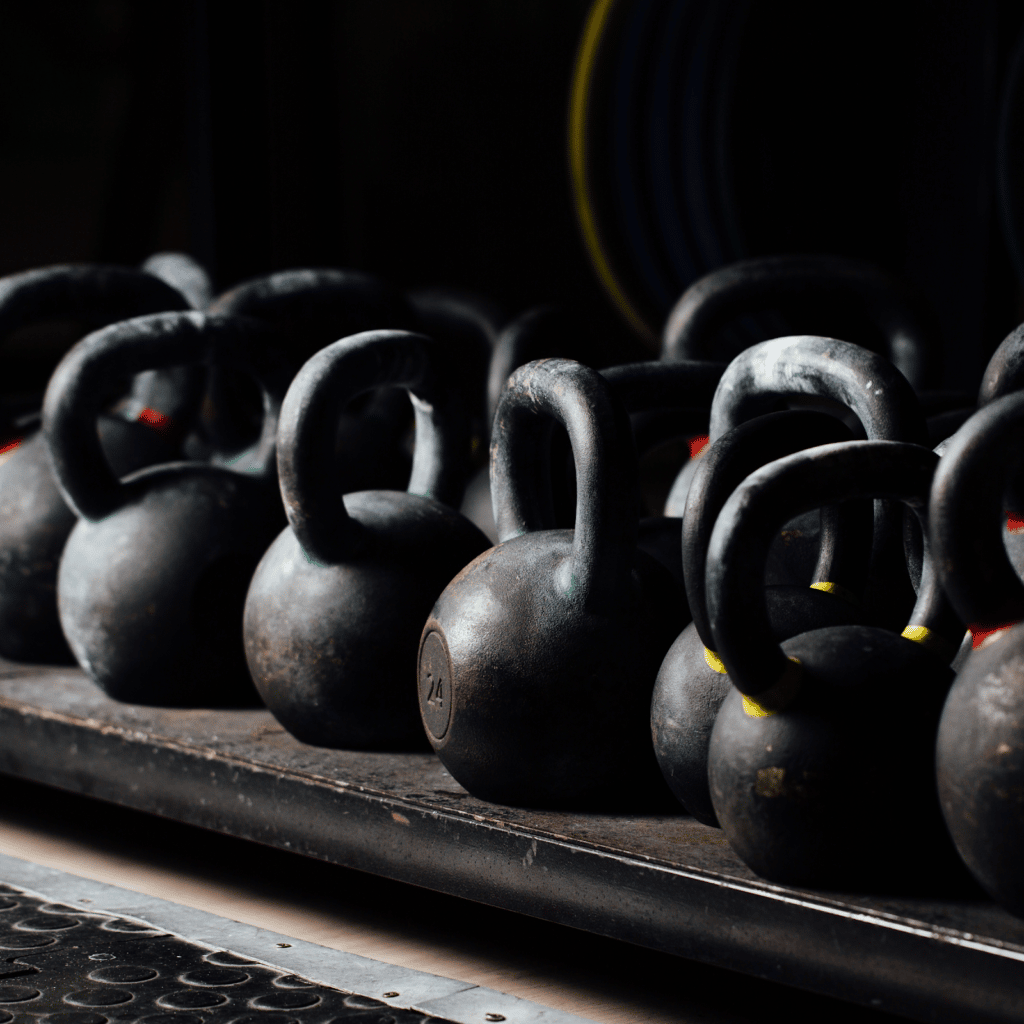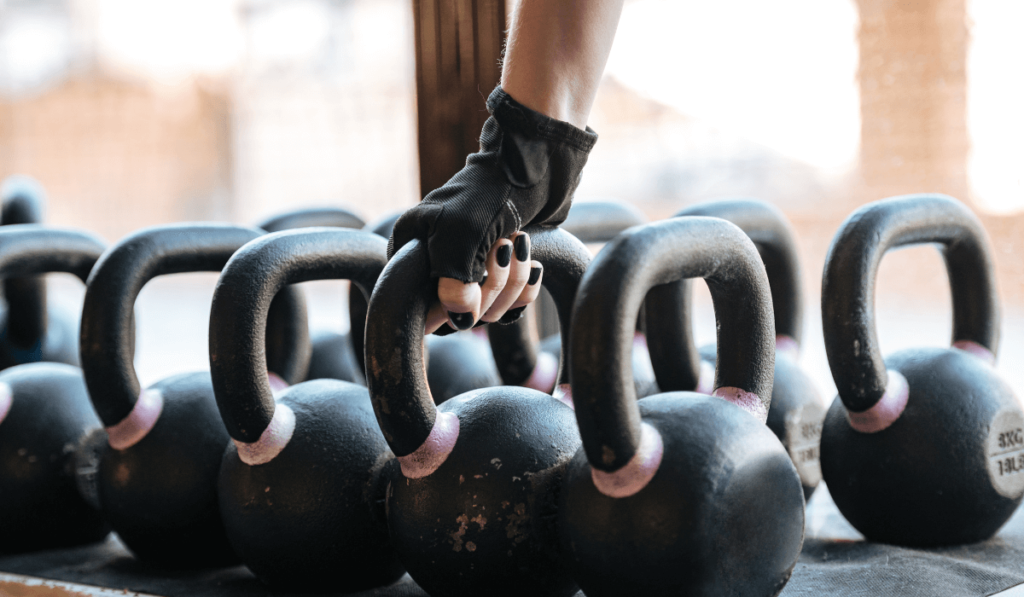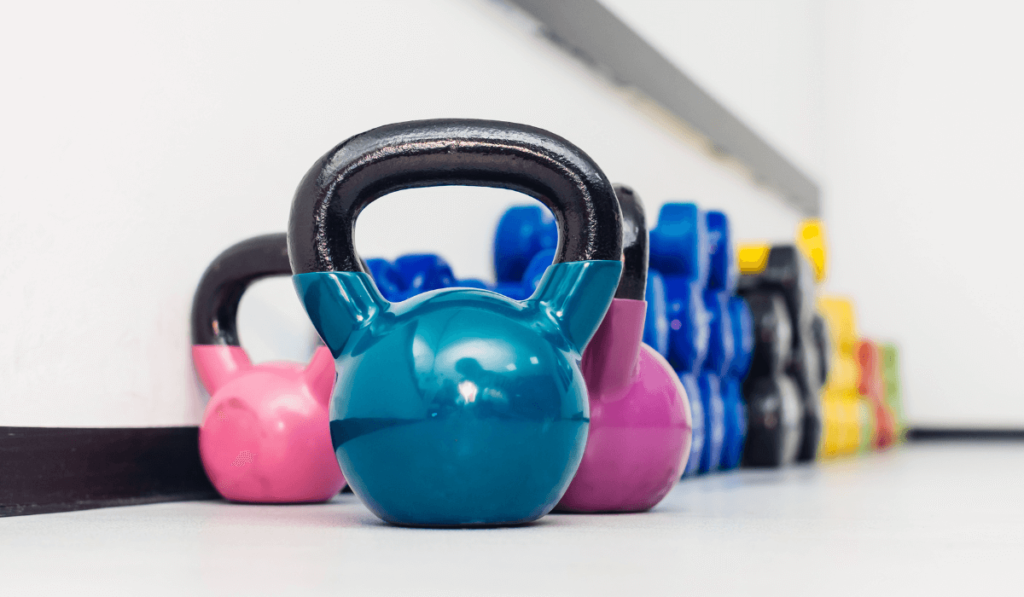Kettlebell training has become a popular tool to reach any fitness goal. The problem is as you progress in strength and skill level you’ll find yourself needing more and more weight.
In this article, we’re going to answer the question “What size kettlebell should I get”. In other words, we are going to be talking about kettlebell weight selection for both men and women. We will provide you with our recommendations for beginners.
Jump to:
Types of Kettlebells
There are two major styles of kettlebells: competition (made of steel) and traditional (made of cast iron). There is a big difference between competition and traditional-style kettlebells.
Competition Kettlebells
In competition-style kettlebells, the shape and size will stay the same regardless of the weight. This means that your technique will only need to adapt to weight changes rather than the size changes of the kettlebell. So this ensures a more stable technique as you transition through the weights.
You can recognize competition kettlebells by them being very colorful and all of them being the same size despite weight changes. So the competition kettlebells look the same. The only difference is the color. So, the color is an international standard. And anytime you see a yellow competition kettlebell, you can be sure that it is 16 kg. Anytime you see a blue one, you can be sure it’s 12 and so on.
Traditional Kettlebells
The size of the traditional-style kettlebell will increase in accordance with its weight. So, your technique will have to adjust not only to the increase in weight but also to the increase in the shape of the kettlebell.
Adjustable Kettlebells
Adjustable weight kettlebells are kettlebells with a weight that can be adjusted. Generally, they are used at home and are cheaper than traditional and competition kettlebells. An adjustable kettlebell allows setting the weight that’s best for you and each exercise you perform.
An adjustable kettlebell can weigh anywhere between 12 kilos up to 32 kilos in one-kilogram increments. Buying all those bells would tally up to nearly a thousand dollars.
The problem with adjustable kettlebells is that they’re fragile. So, the balance feels different than the standard competition kettlebell. However, with some adjustable kettlebells, all the adjustments are made internally. So, the balance and feel are very similar to your standard competition kettlebell. Also, they are very durable, so your kettlebell workouts won’t have to suffer from you being extra careful with them.
What to Consider When Buying a Kettlebell
1. Size of the Handle
A competition-style kettlebell has a narrower, square, and smaller handle diameter in comparison to a traditional-style kettlebell which has a wider, rounder, and larger handle. Due to the demands of kettlebell sport, competition kettlebells are designed to be easier on the grip.
Traditional kettlebells are designed to challenge and improve grip strength. That’s why generally they are slightly thicker than competition-style kettlebells.
Competition kettlebells are meant to be used with one hand only. Due to the nature and requirements of the kettlebell sport, kettlebell sport athletes generally avoid two-hand exercises.
Traditional-style kettlebells are used for strength and conditioning and general physical preparedness. So they can be used with two hands and one hand. Such versatility is useful as it makes it easy to learn any new types of exercises. Due to the shape of the body, these kettlebells are also easier to rack and lockout overhead.
Traditional-style kettlebells are designed for strength and power training. And because of that, you will be using heavier weights for relatively shorter sets. Therefore it is important that you can hang on to your kettlebell when you get sweaty.

2. Do You Use Chalk?
There are two ways to make sure that you hang on to your kettlebell once you get sweaty. The first way is to purchase a kettlebell that is powder coated or a kettlebell with double powder coated. This kettlebell doesn’t require chalk at all. And it’s very useful for people who exercise at home, who are exercising on the carpet and don’t like breathing in chalk, or who just don’t like using chalk.
The cast-iron RKC kettlebell holds chalk well. So if you are using chalk, then when you put it on your hands and grip the kettlebell, you still can hang on to the kettlebell when your hands get sweaty.
3. Coat
The types of kettlebells we don’t recommend purchasing are chrome-cast, vinyl-coated, or metal-handle kettlebells. Those kettlebells have very smooth handles which don’t hold chalk. This means when you get sweaty and the kettlebell starts slipping out of your hand, even if you put chalk on your hands, you’re going to end up with sweaty chalky porridge in your palms, but the kettlebell is still going to be slipping out of your hands.
So, we don’t recommend using polished kettlebell handles. Instead, use either powder-coated or high-quality cast iron kettlebells.
4. The Size of the Kettlebell

Competition kettlebells have a large body that stays the same across all weights. The traditional kettlebell has a smaller body and it increases slightly as the weight of the kettlebell increases. The body size of the kettlebell doesn’t make much difference when you’re swinging a single kettlebell. However, when you’re performing double-handed swings, it might make a difference for you if you’re a small person.
If you’re planning to use kettlebells for building strength and power and you are a small person with short legs, please remember that the wider you have to stand to produce power, the less power you can produce. With a traditional style kettlebell, you can stand much narrower and produce much more power. So, it comes down to the ultimate purpose.
5. Your Fitness Goals
Competition kettlebells are designed for the kettlebell sport. And the reason why they are the size they are is to keep the standard of the sport regardless of whether the person using them is big or small.
Traditional-style kettlebells are designed for strength and conditioning as well as general physical preparedness. Their shape challenges your stability and grip thereby improving them as well as maximizing your power output for strength training.
6. Your Gender
In traditional kettlebell sports, athletic women were only performing single kettlebell exercises. Men were performing double kettlebell exercises. The reason is that it is not advised for women to compress their breasts with their arms or the kettlebells when they perform the exercises. And with double-competition kettlebells, you have to do that. You have to hold the kettlebells quite close to your body.
In traditional style kettlebells, the kettlebells do not have to be held close to the center of your body because the body of the kettlebell is smaller. And women can perform double kettlebell exercises much easier with traditional style kettlebells as well as lift much heavier weights.
So if you’re going to be using double kettlebells either now or eventually, if you are a large long-limbed male, you can choose either and it will be fine.
If you are a smaller shorter female, you might want to use traditional-style kettlebells. Because it will allow you to use heavier weights and express your power better. If you are a female, you might find this helpful in your choices.
7. The Base
Regardless of which style of kettlebell you choose, make sure that your kettlebell has a flat base. Competition-style kettlebells have a wider base and therefore are more stable in floor exercises. They are also marginally higher off the ground. But unless you are short it doesn’t make much difference.
Traditional-style kettlebells have a smaller base which makes them a challenge to balance. The smaller and lighter a kettlebell, the harder is to balance on it.
Some of the traditional kettlebells of lesser quality do not have a flat base. The vinyl-coated kettlebells with a rubber body generally don’t have a flat base. It makes ballistic exercises both difficult and dangerous.
8. Quality
Remember as long as you buy good quality, you’re going to get great use out of this kettlebell. When you take the time to learn how to use kettlebells, you can get great training value out of almost any size kettlebell weight. No matter your skill and current fitness level. Make sure you invest in quality kettlebells. They’re going to last you a lifetime and they’ll pay for themselves many times over.
Standard Kettlebell Sizes: What sizes do kettlebells come in?

Kettlebells being a Russian invention are weighed in kilograms. And they traditionally come in four-kilogram increments. So that’s usually 8 kilograms, then 12, 16, 20, 24, 28, and 32 kilograms. Of course, they make kettlebells much heavier than these. But talking about your most popular choices and what you’re going to be using most often, that’s the weight spectrum that you’re going to fall in.
What Size Kettlebell Should I Get?
Kettlebell Sizes for Beginners
We are breaking our recommendation down into two sets of three kettlebells each. Your first set will probably be all you need for your training for at least your first six months or the first several years of training depending on your goals.
For some beginners, it may be appropriate to start with an 8-kilo kettlebell. Some kettlebell companies make traditional kettlebells with a 2-kilo increment. So, you can also try a 10-kilo or a 12-kg kettlebell and a 16-kg kettlebell starting weight. So, those three perfect kettlebells are going to take you a long way. If and when you’re ready to move up your weight for beginners to a heavier weight that’s probably going to be for your swings and squats.
We are going to recommend a pretty big jump to 24 kilos when you start to get into your second set. That’s usually because if you’ve been practicing a 16-kilogram swing, getting up to 20 is certainly going to be a little bit more challenging. But oftentimes, we find that the sweet spot for a good heavy two-hand swing is in that 24-kilo weight range.
So that’s why we recommend going ahead and making that eight-kilogram increment. Because after six to 12 months of training with kettlebells, you’re probably going to be able to handle that weight for your swings and kettlebell goblet squats.
And then to round out the set, we recommend going heavier and lighter. This is up to you. You could go ahead and get a second 12-kilogram kettlebell to complete your first pair. Working double kettlebells is a fantastic way to train. And getting started with double twelves is usually a great place for most beginners to start for presses and double kettlebell swings.
Kettlebell Sizes For Men
For men, the thought process behind your kettlebell selection is the same. We’re thinking about bumping the weights a little bit heavier. So, make sure you have a light, a medium, and a heavier weight.
For most guys, that’s going to be 12, 16, and 24 kilograms. Think about the lightest kettlebells being something that you can press overhead confidently and safely for sets of five. And your heavier weight is something that’s going to serve your squat and swing training for at least your first six months of training. So this kettlebell set is going to be your training weight for probably your entire life.
When it comes to investing in your second set of three kettlebells, we would recommend you bump up a little bit. Go ahead and snag 32-weight kettlebells and that’s probably going to be the heaviest that you’re going to practically need to use.
For your next two kettlebells, there’s some room for interpretation. A pair of 20-kilo kettlebells is a great sweet spot weight for a lot of double kettlebell complexes. If you’re on the stronger side, you might want to pick up an extra 24 to complete your set. If double 20s feels a little ambitious, then maybe just get a second 16-kg kettlebell weight. Once we’ve got those first three bells in tow, then our next three we can stack on to those.
Kettlebell Sizes For Women
If you’re an active woman that asks “What size kettlebell should I get”, you can start with an 8-kilogram, 12, and 16-kilogram kettlebell. The idea should be that your lighter kettlebell is something that you can confidently press overhead for sets of five. And your heaviest kettlebells should be hefty enough, that it’s challenging but doable for sets of six to ten squats. And then your middleweight is going to be between.
So, the starting weight might need to be a little bit lighter. Kettlebell sets traditionally start at eight kilograms. But some manufacturers do make them lighter. For example, you can start at six kilograms.
If you feel like you want to push your kettlebell swings even heavier, the 20-kilo is a great training weight for those heavier kettlebell swings and squats. It depends on your strength level.

Sizes of Kettlebells for Seniors
Depending on your weight training experience, you can use 8-16 kg kettlebells. Make sure you have something light enough that you can do simple exercises and overhead work with no problem. And even a more advanced-level type of exercise like windmills, and bottoms-up presses. And you have some options in the middle for snatches, one-handed kettlebell swings, and different squat variations.
If you’re on the stronger side, you might even want to bump into a pair of 16kg weight-size kettlebells. And then you have the biggest kettlebell that is heavy enough to serve your swing training for years to come. So, with those three kettlebells, you have all of your bases covered.
If you want something that’s going to cover all your lifts, overhead, and mobility-based work, your swing strength will push you into those heavier weights. Working doubles is going to be somewhere in the middle. Also, you’re going to get a lot of value out of those moderate-size weights when working on your more advanced techniques like snatches.
Is Your Kettlebell Too Heavy?
Sometimes making the jump from an 8-kg starter kettlebell to a 12 is just too big of a jump to be appropriate. How to know if your kettlebell is too heavy? If you can’t perform your ballistic exercises properly, you are using the wrong kettlebell weight.
If we were doing a kettlebell clean or a kettlebell snatch, we have to learn how to do those kettlebell movements properly. You may be strong and you may be able to lift a lot of weight. But if you are lifting a kettlebell without proper mechanics, and you’re just smashing out to the side, you are going to load up your joint health.
How Many Kettlebells Do I Need?
A kettlebell is one of the best at-home workout tools. You don’t need many kettlebells. Generally, it’s enough to have one kettlebell for performing effective kettlebell training. But you can use two or more kettlebells with different weights to get even more out of your training.
In fact, just three kettlebells will take you a long way, even your first two or three years of training. And then on top of that, you only need a few more that will last a lifetime.
Kettlebell FAQs:
What size kettlebell should you start with?
If you are man and start at the beginner level, your first kettlebell should be 10-12 kg or 22-26 lb. For an average active woman, starting with a 6-8 kg (13-18 lb) kettlebell is perfect.
What weight kettlebell should a beginner use?
The best kettlebell size for a beginner will depend on age, gender, exercises, and workout goals. For a man beginner, it’s about 22-26 pounds (10-12 kg). If you are a female beginner, we suggest starting with 6 kg (13 lbs) or 8 kg (18 lbs) for most lifts.
What weight kettlebell should a female beginner use?
A 13 lb (6 kg) kettlebell is perfect for an average woman to start with. Remember that choosing the right weight makes your kettlebell training more effective. It also prevents you from possible injuries.















